Kagan's Articles - FREE Kagan Articles
Research & Rationale
Student Perceptions of Kagan Cooperative Learning Structures
Special Article
Student Perceptions of Kagan Cooperative Learning Structures
Dr. Michael Winters
Executive Director for Curriculum and Instruction, Madison Elementary School District
Rebecca Galindo
5th grade English Language Arts teacher, Madison Park Middle School
To cite this article: Winters, M. & R. Galindo. Student Perceptions of Kagan Cooperative Learning Structures. Kagan Online Magazine, Issue #57. San Clemente, CA: Kagan Publishing. www.KaganOnline.com

Madison Park Middle School is a 5th through 8th grade school located in central Phoenix. The school serves approximately 380 students with 10% Native American, 1% Asian, 8% Black, 66% Hispanic, and 16% White. The free and reduced lunch percentage is 75% with 11% of the students receiving special education services and 8% of the students receiving English Language Learner services. Madison Park's feeder elementary is Madison Camelview Elementary School and the subject of an article I wrote entitled Earning A Grades with Kagan that appeared in the Fall 2014/Winter 2015 edition of the Kagan Online Magazine. When students arrive to attend 5th grade at Madison Park, they have already had many Kagan Cooperative Learning experiences.
Rebecca Galindo is a 5th grade English Language Arts teacher at Madison Park Middle School. Her students come to Park from Camelview Elementary where they have high implementation of Kagan Cooperative Learning Structures. Mrs. Galindo's students from 2015-2016 were first introduced to Kagan Structures as 1st graders and have been actively engaged in their classrooms ever since. As part of Mrs. Galindo's masters in education administration program at Arizona State University, she was required to conduct an action research project. Her project focused on the 5th grade students' perceptions of learning with and without Kagan Cooperative Learning Structures. The student feedback was insightful and demonstrated an overwhelming preference for learning through the use of structures.
To collect student perceptual data, Mrs. Galindo administered a four-item survey using a five-point (0 to 4) Likert scale to 63 5th grade students. A score of 0 represented Strongly Disagree while a score of 4 represented Strongly Agree. She asked the students to respond to the following statements:
- Cooperative learning structures provide me the opportunity to learn more in class.
- Cooperative learning structures enhance my level of engagement during a lesson.
- I like working independently on given tasks during class.
- Cooperative learning structures make it difficult for me to learn the content.
The results provided insight into the students' viewpoints on cooperative learning structures and how the structures help the students engage in their learning. Graphic representations of the survey results follow.
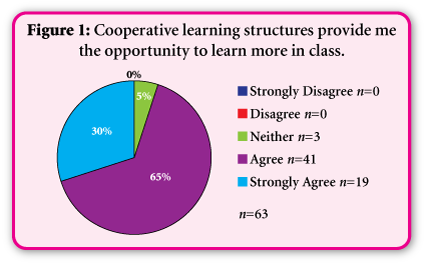
The results displayed in Figure 1 reveal 95% (60/63) of students surveyed believe cooperative learning structures provide them the opportunity to learn more in class.
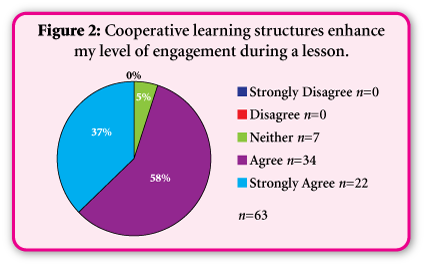
The results displayed in Figure 2 reveal 89% (56/63) of students surveyed believe cooperative learning structures enhance their level of engagement during lessons.
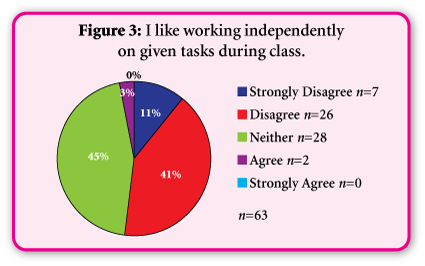
The results displayed in Figure 3 reveal 52% (33/63) of students surveyed do not like working independently on given tasks during class with 44% (28/63) remaining neutral.
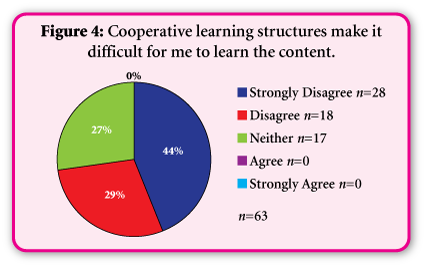
The results displayed in Figure 4 reveal 73% (46/63) of students surveyed believe cooperative learning structures make learning content easier with 27% (17/63) remaining neutral.
The results from this study provided insight into student perceptions of cooperative learning structures. Clearly, students' overwhelming preference is to work on cooperative teams or pairs. Students clearly believe structures help them be more actively engaged in the learning process while making learning easier. The implications of this study suggest teachers who incorporate cooperative learning structures provide students with a more engaging learning experience while enhancing the students' levels of learning. If the students themselves are telling us as educators that they prefer to use cooperative learning structures over independent work, all teachers should employ cooperative learning structures to address and satisfy student preferences. Extending this research to other groups of students would be valuable.
Duplicating this research with other groups of students in the Madison Elementary School District and with students throughout the country would provide researchers and educators with a look into the minds of students. If the results of this study are similar with other student populations, administrators could use the students' responses to encourage teachers to be student-centered and use cooperative learning structures throughout each and every instructional day.
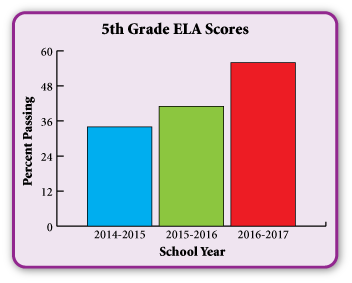
Arizona changed standardized tests starting with the 2014-2015 school year. Therefore, Mrs. Galindo has two years of 5th grade ELA data to demonstrate growth. The following graph compares the 5th grade ELA scores for the first two years of AzMERIT, the new Arizona assessment. The new test resulted in state-wide drops in proficiency rates. While 34% and 41% passing does not seem great, Madison Park Middle School's AzMERIT scores rank in the 56th percentile when compared to schools with like demographics.